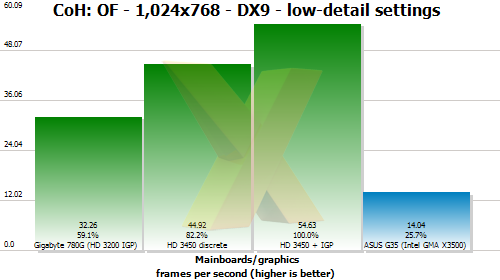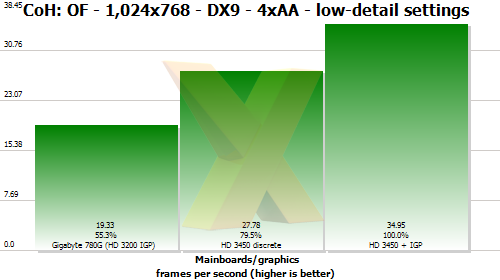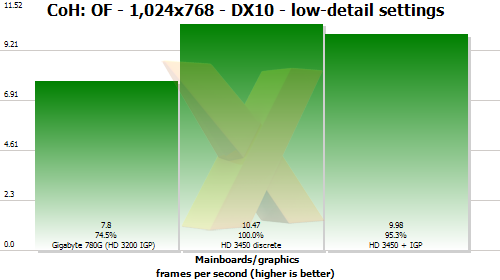Gaming
Gaming is where the 780G's Radeon HD 3200 should show the Intel G35 a clean pair of heels. Remember that Intel publicly disseminates the G35's X3500 as a DX10-compliant GPU, but it will be at least six months before we see any supporting drivers, hence no DX10 scores in our benchmark look.HEXUS has tended to look upon IGPs as a provider of mediocre gaming performance that's limited to, really, 640x480. This time, knowing the HD 3200's attributes, we've raised the resolution bar to 1,024x768 but kept image-quality settings to a minimum.

An average 60fps frame-rate is desirable but anything consistently above 30fps is enough to play the game smoothly. As such, the ~50fps average of the 780G's IGP is over twice as fast as the G35's X3500.
A discrete Radeon HD 3450, clocked in at 600MHz engine and 1GHz memory, is around 40 per cent faster than the 780G, but teaming the two together - where the engine speed is reduced to the lowest denomintaor, 500MHz - increases discrete performance by a further 16 per cent for, effectively, free.
It's worth remembering that the onboard IGP uses the system's memory bandwidth, which is just 717MHz and inelegant when compared to the on-PCB modules for a discrete card.

The texture-heavy Enemy Territory: Quake Wars exacts a far greater toll on IGPs. Intel's X3500 renders unplayable frame-rates whilst the Radeon HD 3200 IGP's performance can be considered playable, just.
Here, a discrete HD 3450 card, retailing at around £25, is around 35 per cent faster, but teaming the two together, via Hybrid CrossFire, adds a further 13 per cent.
Of course, the same HD 3450 256MiB card could be placed in the Intel platform and would benchmark at roughly the same levels.

Again, we see a >30fps average frame-rate in Company of Heroes: Opposing Fronts, which is double that of the X3500. A discrete card is around 40 per cent faster, sure, but scaling is such that an extra 22 per cent is gained when activating the onboard IGP via the CATALYST Control Centre's CrossFire tab.

Here, we've run the same test but included 4x AA, which the Intel X3500 cannot do. Hybrid CrossFire adds 26 per cent over the HD 3450's performance and makes the game playable.

What of DX10 gameplay, then? The answer is that all low-end cards and IGPs suffer terribly with the code-path in CoH. Indeed, CrossFire scaling provides no frame-rate benefit and the overhead is manifested in a lower-than-expected score.
Gaming summary
3D performance is at least twice that of Intel's X3500, found on the G35 chipset. You should be able to play most games at 1,024x768 with low-to-medium image-quality settings and still have fluid frame-rates.It's still not as fast as a low-end discrete card, of course, but the IGP can provide an up-to 25 per cent boost to a HD 3450's benchmarks when leveraged in Hybrid CrossFire.









